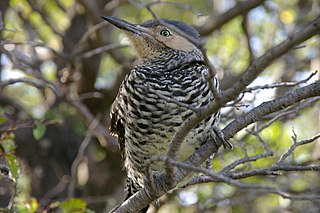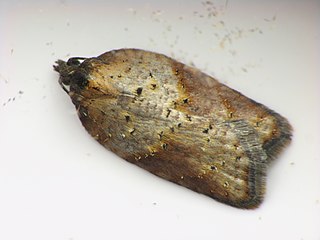
The northern flicker or common flicker is a medium-sized bird of the woodpecker family. It is native to most of North America, parts of Central America, Cuba, and the Cayman Islands, and is one of the few woodpecker species that migrate. Over 100 common names for the northern flicker are known, including yellowhammer, clape, gaffer woodpecker, harry-wicket, heigh-ho, wake-up, walk-up, wick-up, yarrup, and gawker bird. Many of these names derive from attempts to imitate some of its calls. It is the state bird of Alabama.

The Tortricidae are a family of moths, commonly known as tortrix moths or leafroller moths, in the order Lepidoptera. This large family has over 11,000 species described, and is the sole member of the superfamily Tortricoidea, although the genus Heliocosma is sometimes placed within this superfamily. Many of these are economically important pests. Olethreutidae is a junior synonym. The typical resting posture is with the wings folded back, producing a rather rounded profile.

The golden-olive woodpecker is a species of bird in the subfamily Picinae of the woodpecker family Picidae. It is found from Mexico south and east through Panama, in every mainland South American country except Chile, Paraguay, and Uruguay, and Trinidad and Tobago.

The gilded flicker is a large woodpecker of the Sonoran, Yuma, and eastern Colorado Desert regions of the southwestern United States and northwestern Mexico, including all of Baja California, except the extreme northwestern region. Yellow underwings distinguish the gilded flicker from the northern flicker found within the same region, which has red underwings.

Colaptes is a genus of birds in the woodpecker family Picidae. The 14 species are found across the Americas.

The Archipini are a tribe of tortrix moths. Since many genera of these are not yet assigned to tribes, the genus list presented here is provisional.

The campo flicker is a species of bird in subfamily Picinae of the woodpecker family Picidae. It is found in Argentina, Bolivia, Brazil, Paraguay, Suriname, and Uruguay.

The Chilean flicker is a species of bird in subfamily Picinae of the woodpecker family Picidae. It is found in Argentina and Chile.

The Andean flicker is a species of bird in subfamily Picinae of the woodpecker family Picidae. It is found in Argentina, Bolivia, Chile, Ecuador, and Peru.

The grey-crowned woodpecker is a species of bird in subfamily Picinae of the woodpecker family Picidae. It is endemic to western Mexico.

The Cochylini are a tribe of tortrix moths. It used to be classified as the subfamily Cochylinae.
Atepa is a genus of moths belonging to family Tortricidae.

The Euliini are a tribe of tortrix moths.

The Tortricini are a tribe of tortrix moths.
Alexey Nikolaievich Diakonoff, also transliterated as Alexej Nikolajewitsch Diakonoff, was a Russian–Dutch entomologist who specialised in Microlepidoptera.
The Bermuda flicker is an extinct woodpecker from the genus Colaptes. It was confined to Bermuda and is known only by fossil remains dated to the Late Pleistocene and the Holocene. However, an old travel report by explorer Captain John Smith from the 17th century may also refer to this species.
Atepa cordobana is a species of moth of the family Tortricidae. It is found in Veracruz, Mexico.
Atepa sinaloana is a species of moth of the family Tortricidae. It is found in Sinaloa, Mexico.
Atepa triplagata is a species of moth of the family Tortricidae. It is found in Tabasco, Mexico.











